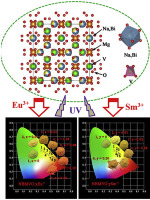Dyes and Pigments ( IF 4.5 ) Pub Date : 2018-03-27 , DOI: 10.1016/j.dyepig.2018.03.050 Kai Li , Rik Van Deun

|
In this article, we acquire a novel Na2BiMg2(VO4)3 phase (abbreviated as NBMVO) via the substitution of Ca2+ by Na+ and Bi3+ ions in Ca2NaMg2(VO4)3. A series of Eu3+/Sm3+-doped Na2BiMg2(VO4)3 phosphors were synthesized via a high-temperature solid-state reaction route. XRD patterns for the prepared samples can be assigned to the standard Ca2NaMg2(VO4)3 phase. For the Na2BiMg2(VO4)3 host, the emission spectrum shows a wide band from 400 to 800 nm peaking at 535 nm under the optimal 378 nm excitation, which can be deconvoluted into two symmetric bands around 521 and 579 nm corresponding to transitions 3T2→1A1 and 3T1→1A1 from the (VO4)3- group, respectively. Monitored at 535 nm, the excitation spectrum exhibits a broad band with two peaks at 378 nm (26455 cm−1) and 324 nm (30864 cm−1), which originate from the transitions 1T2←1A1 and 1T1←1A1 of the (VO4)3- tetrahedron, respectively. When Eu3+ or Sm3+ is doped into the host, the emission spectra display both the host and the Eu3+ or Sm3+ characteristic emission peaks upon 378 nm excitation, moreover, the excitation spectra monitored at the Eu3+ (607.5 nm) or Sm3+ (650 nm) characteristic peaks contain both the host excitation band as well as the Eu3+ or Sm3+ characteristic excitation peaks. These results demonstrate an efficient energy transfer from the host to the Eu3+ or Sm3+ ions. Furthermore, the variation of the emission spectra for samples doped with different Eu3+ or Sm3+ contents under 378 nm excitation (witnessed by a color change from yellowish green to orange/light orange upon 365 nm UV lamp excitation) and the corresponding decay times are further used to validate the energy transfer from the (VO4)3- group to the doped ions. The energy transfer mechanisms for NBMVO:Eu3+ and NBMVO:Sm3+ are determined to be electric dipole-quadrupole and dipole-dipole interactions, respectively. These results suggest that these materials have potential as candidate phosphors in UV/n-UV w-LED applications.
中文翻译:

Eu 3+ / Sm 3+掺杂的Na 2 BiMg 2(VO 4)3,由Ca 2 NaMg 2(VO 4)3中的Na +和Bi 3+取代Ca 2+:通过有效的能量转移进行颜色可调的发光从(VO 4)3-到Eu 3+ / Sm 3+离子
在本文中,我们通过在Ca 2 NaMg 2(VO 4)3中用Na +和Bi 3+离子取代Ca 2+,获得了新颖的Na 2 BiMg 2(VO 4)3相(缩写为NBMVO)。通过高温固态反应路线合成了一系列掺杂Eu 3+ / Sm 3+的Na 2 BiMg 2(VO 4)3荧光粉。制备样品的XRD图谱可以指定为标准Ca 2 NaMg 2(VO4)3相。对于Na 2 BiMg 2(VO 4)3主体,在最佳378 nm激发下,发射光谱显示在535 nm处有一个400至800 nm的峰值峰,可以将其解卷积为521和579 nm附近的两个对称谱带分别从(VO 4)3-基跃迁到3 T 2 → 1 A 1和3 T 1 → 1 A 1。在535 nm处监控,激发光谱显示出一个宽带,在378 nm(26455 cm -1)处有两个峰)和324 nm(30864 cm -1),分别来自(VO 4)3-四面体的跃迁1 T 2 ← 1 A 1和1 T 1 ← 1 A 1。当将Eu 3+或Sm 3+掺杂到主体中时,发射光谱同时显示主体和378 nm激发时Eu 3+或Sm 3+的特征发射峰,此外,在Eu 3+( 607.5 nm)或Sm 3+(650 nm)特征峰既包含主体激发带,也包含Eu 3+或Sm 3+特征激发峰。这些结果证明了从主体到Eu 3+或Sm 3+离子的有效能量转移。此外,掺杂了不同Eu 3+或Sm 3+含量的样品在378 nm激发下(经365 nm UV灯激发,颜色从黄绿色变为橙色/浅橙色)的发射光谱变化和相应的衰减时间进一步用于验证从(VO 4)3-基团到掺杂离子的能量转移。NBMVO:Eu的能量转移机制3+和NBMVO:Sm 3+被确定分别是电偶极-四极和偶极-偶极相互作用。这些结果表明,这些材料在UV / n-UV w-LED应用中具有作为候选磷光体的潜力。



























 京公网安备 11010802027423号
京公网安备 11010802027423号